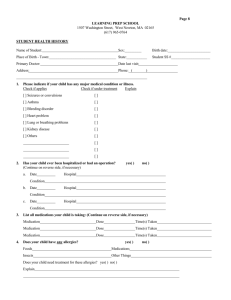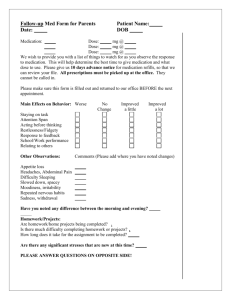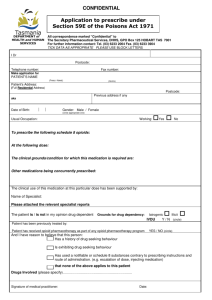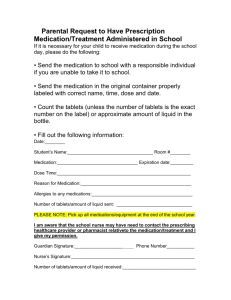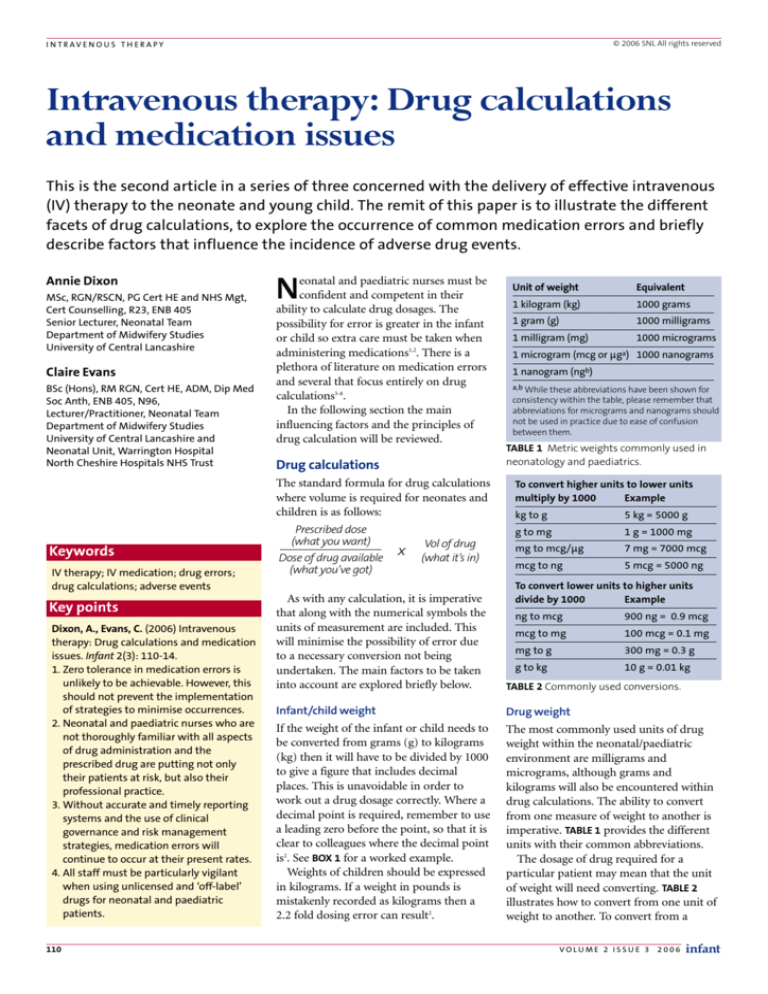
© 2006 SNL All rights reserved
I N T R AV E N O U S T H E R A P Y
Intravenous therapy: Drug calculations
and medication issues
This is the second article in a series of three concerned with the delivery of effective intravenous
(IV) therapy to the neonate and young child. The remit of this paper is to illustrate the different
facets of drug calculations, to explore the occurrence of common medication errors and briefly
describe factors that influence the incidence of adverse drug events.
Annie Dixon
MSc, RGN/RSCN, PG Cert HE and NHS Mgt,
Cert Counselling, R23, ENB 405
Senior Lecturer, Neonatal Team
Department of Midwifery Studies
University of Central Lancashire
Claire Evans
BSc (Hons), RM RGN, Cert HE, ADM, Dip Med
Soc Anth, ENB 405, N96,
Lecturer/Practitioner, Neonatal Team
Department of Midwifery Studies
University of Central Lancashire and
Neonatal Unit, Warrington Hospital
North Cheshire Hospitals NHS Trust
N
eonatal and paediatric nurses must be
confident and competent in their
ability to calculate drug dosages. The
possibility for error is greater in the infant
or child so extra care must be taken when
administering medications1,2. There is a
plethora of literature on medication errors
and several that focus entirely on drug
calculations3-8.
In the following section the main
influencing factors and the principles of
drug calculation will be reviewed.
Drug calculations
The standard formula for drug calculations
where volume is required for neonates and
children is as follows:
Keywords
IV therapy; IV medication; drug errors;
drug calculations; adverse events
Key points
Dixon, A., Evans, C. (2006) Intravenous
therapy: Drug calculations and medication
issues. Infant 2(3): 110-14.
1. Zero tolerance in medication errors is
unlikely to be achievable. However, this
should not prevent the implementation
of strategies to minimise occurrences.
2. Neonatal and paediatric nurses who are
not thoroughly familiar with all aspects
of drug administration and the
prescribed drug are putting not only
their patients at risk, but also their
professional practice.
3. Without accurate and timely reporting
systems and the use of clinical
governance and risk management
strategies, medication errors will
continue to occur at their present rates.
4. All staff must be particularly vigilant
when using unlicensed and ‘off-label’
drugs for neonatal and paediatric
patients.
110
Prescribed dose
(what you want)
Dose of drug available
(what you’ve got)
x
Vol of drug
(what it’s in)
Unit of weight
Equivalent
1 kilogram (kg)
1000 grams
1 gram (g)
1000 milligrams
1 milligram (mg)
1000 micrograms
1 microgram (mcg or µga) 1000 nanograms
1 nanogram (ngb)
a,b While these abbreviations have been shown for
consistency within the table, please remember that
abbreviations for micrograms and nanograms should
not be used in practice due to ease of confusion
between them.
TABLE 1 Metric weights commonly used in
neonatology and paediatrics.
To convert higher units to lower units
multiply by 1000
Example
kg to g
5 kg = 5000 g
g to mg
1 g = 1000 mg
mg to mcg/µg
7 mg = 7000 mcg
mcg to ng
5 mcg = 5000 ng
To convert lower units to higher units
divide by 1000
Example
As with any calculation, it is imperative
that along with the numerical symbols the
units of measurement are included. This
will minimise the possibility of error due
to a necessary conversion not being
undertaken. The main factors to be taken
into account are explored briefly below.
TABLE 2 Commonly used conversions.
Infant/child weight
Drug weight
If the weight of the infant or child needs to
be converted from grams (g) to kilograms
(kg) then it will have to be divided by 1000
to give a figure that includes decimal
places. This is unavoidable in order to
work out a drug dosage correctly. Where a
decimal point is required, remember to use
a leading zero before the point, so that it is
clear to colleagues where the decimal point
is2. See BOX 1 for a worked example.
Weights of children should be expressed
in kilograms. If a weight in pounds is
mistakenly recorded as kilograms then a
2.2 fold dosing error can result2.
The most commonly used units of drug
weight within the neonatal/paediatric
environment are milligrams and
micrograms, although grams and
kilograms will also be encountered within
drug calculations. The ability to convert
from one measure of weight to another is
imperative. TABLE 1 provides the different
units with their common abbreviations.
The dosage of drug required for a
particular patient may mean that the unit
of weight will need converting. TABLE 2
illustrates how to convert from one unit of
weight to another. To convert from a
ng to mcg
900 ng = 0.9 mcg
mcg to mg
100 mcg = 0.1 mg
mg to g
300 mg = 0.3 g
g to kg
10 g = 0.01 kg
VOLUME 2 ISSU E 3 2006
infant
I N T R AV E N O U S T H E R A P Y
A baby weighing 780 g needs a dopamine infusion of 5 mcg/kg/min for hypotension. The
dopamine ampoule contains 40 mg/mL. The infusion is to be made up to 36 mL with 5%
dextrose. How much dopamine needs to be added to the syringe if the rate is 0.5 mL/hr?
There are several steps involved in working out this calculation. The first step is to work
out the amount of drug the baby needs.
Baby weight conversion
The baby’s weight needs converting to kg:
780 g ÷ 1000 = 0.78 kg
Next, the amount of drug the baby requires should be calculated.
5 mcg x 0.78 kg/min = 3.9 mcg/min
Rate conversion
As the dopamine is to be given as an infusion, the next step is to work out how much the
baby will require each hour, as currently the amount is per minute.
3.9 mcg x 60 minutes = 234 mcg/hour
The infusion is to be made up to 36 mL. As the infusion is to run at 0.5 mL/hr this means
that 1 mL will infuse in 2 hours and 36 mL will take 72 hours* to infuse.
Volume
The most commonly used units of volume
within children’s nursing are millilitres
(mL). Generally, IV infusion solutions
come in one litre bags (equivalent to
1000 mL), but in practice neonatal and
paediatric nurses will commonly use
500 mL bags. The ability to convert from
one measure of volume to another is
important. To convert litres to millilitres,
multiply the number of litres or part litres
by 1000. To convert millilitres to litres,
divide the number of millilitres by 1000.
It is preferable to convert volumes to
maintain whole numbers within the calculation rather than using decimal points.
Therefore the amount to be added to the syringe is 234 mcg x 72 hours = 16,848 mcg.
Rate
Drug weight conversion
It is important to follow the guidelines for
the length of time over which a drug can
be administered. This prevents any
complications that may occur from the
drug being given too rapidly or slowly. For
example, acyclovir must be infused slowly
over one hour9 to prevent renal tubular
damage10.
In addition, for drugs where the dose is
prescribed as a number of micrograms per
minute, remember that for infusions the
amounts need to be calculated for an
hour’s worth of infusate. For a worked
example see BOX 1.
40mg/mL of dopamine needs converting into micrograms: 40 mg x 1000 = 40,000 mcg
Thus the calculated amount needed is:
16,848 mcg (prescribed dose)
x 1 mL (volume of drug)
= 0.4212 mL
40,000 mcg (dose of drug available)
So 0.42 mL needs to be drawn up from the dopamine vial to be added to 35.6 mL of 5%
dextrose.
* Please note that whilst the syringe in this example contains 72 hours worth of infusate this would
still be changed daily as dopamine becomes unstable after 24 hours.
BOX 1 Example of a drug calculation incorporating baby weight, drug weight and rate
conversions.
A baby requires a 240 mcg injection of morphine. The vial of morphine contains 1 mg/mL.
In order to calculate how much morphine the baby needs a weight conversion must be
done as the units of weight are different.
Thus,
Dosage/frequency
To convert 1 mg into micrograms the following calculation is made:
Most drugs have to be given more than
once a day, at specified time intervals. Not
all information on drugs is provided in this
format. It is important that nurses are able
to calculate the time interval between doses
and how much should be given per dose.
See BOX 3 for a worked example.
1 mg x 1000 = 1000 micrograms.
This conversion enables the drug calculation to be worked out as follows:
240 mcg
1000 mcg
x 1 mL = 0.24 mL
BOX 2 Drug weight conversion example.
A baby weighing 1.2 kg is prescribed 1.5 mg per kg as a total daily dose, to be given at 6
hourly intervals. How much should be given per dose and how many times a day should
the child receive the medicine?
In this example firstly the total daily dose requires calculating.
1.5 mg/kg x 1.2 kg = 1.8 mg
Total daily dose per 24 hours
Next the number of doses a day requires working out.
24 hrs ÷ 6 (hours) = 4 times/day
Lastly the amount needed at each dose can be calculated
1.8 mg/day ÷ 4 = 0.45 mg/ dose
BOX 3 Dosage frequency calculations.
higher unit of weight to a lower one
multiply by 1000, alternatively, to convert
from a lower unit of weight to a higher
divide by 1000. When conversion is
required it is preferable to convert the
higher unit of weight to the lower one.
infant
VOLUME 2 ISSU E 3 2006
This ensures that the figures remain as
whole numbers rather than including
decimal places and helps to reduce the
potential for the decimal place to be
positioned incorrectly. See BOX 2 for a
worked example.
Weight/volume
The amount of drug in a given volume can
also be expressed in more than one way.
The most common of these that a
neonatal/paediatric nurse may encounter
are reviewed below.
Weight in volume expressed as a percentage
When a drug is expressed as a percentage
this indicates the number of grams in
100 mL of diluent, e.g. a 1% solution is 1
gram of drug in every 100 mL of fluid. See
BOX 4 for worked example.
Moles and millimoles
The strength of intravenous infusion fluids
and the concentration of substances in
body fluids are often expressed in
111
I N T R AV E N O U S T H E R A P Y
millimoles per litre (mmol/L). For the
purposes of most calculations a mole or a
millimole can be regarded as an amount,
but it actually refers to a certain number of
atoms or molecules.
A millimole is one thousandth of a mole.
Thus 1,000 mmol = 1 mole.
For medications prescribed in mmol the
formula for calculation remains the same.
See BOX 5 for worked example.
Other options
Some drugs are expressed as 1 in 1000 or
1:10,000 solutions, for example, adrenaline.
Similarly to the previous example, this
denotes a specific amount of drug in a
given volume.
1 in 1000 is 1g in 1000 mL solution
1 in 10,000 is 1g in 10,000 mL solution
A baby is prescribed 84 mg of 4.2% of sodium bicarbonate. What volume does the child
need to receive the right dose?
A 4.2% solution of sodium bicarbonate will contain 4.2 g of sodium bicarbonate per
100 mL of solution.
First convert the 4.2 g into milligrams so that the units of drug weight are the same.
4.2 g x 1000 = 4200 mg
Next work out how many mL of solution the baby should receive.
84 mg
4200 mg
x 100 mL = 2 mL
BOX 4 Calculating drugs expressed as percentages.
A baby is to receive 3 mmol of potassium chloride by infusion. The vial contains 20 mmol
per 10 mL of potassium chloride. How much of this solution should be added to the
infusion?
The infant needs 3 mmol of potassium
We have 20 mmol in each 10 mL of solution
The units are the same so no conversion is required
Thus:
Displacement values
3 mmol
Displacement values need to be accounted
for whenever reconstitution from a dry
powder or crystalline form is required.
Whilst displacement values are of no
interest if a complete vial is to be given, for
smaller children and neonates this is often
not the case. The displacement value can
affect the amount of drug given if it is not
taken into account.
The easiest way to address this is to
consider the displacement value as part of
the final volume. Thus, the displacement
value needs to be subtracted from the total
volume of fluid that would be used to
reconstitute the vial. Neonatal and
paediatric textbook drug guides are
commonly used and contain specific
information for these population groups9,11.
20 mmol
x 10 mL
= 1.5 mL
BOX 5 Drug calculation expressed in mmols.
The baby needs 0.1 unit of insulin/hour. The insulin vial contains 100 units/mL. What
dilutions would you make to prepare a 30 mL syringe to deliver a dose of 0.1 unit/mL?
If this calculation were worked through as normal
0.1 unit
100 units
x 1 mL
= 0.001 mL
It is not possible to draw up 0.001 mL accurately and thus it would be very difficult to
administer the correct concentration of insulin to the baby using this method.
Thus in this instance it is helpful to use the following:
In 1 mL there are 100 units of insulin therefore:
In 0.1 mL there are 10 units of insulin.
Draw 0.1 mL of insulin solution up into a syringe and make this up to 1 mL with diluent.
This gives a total concentration of 10 units in a mL. This is a much more manageable way
to calculate the amount needed for this baby.
0.1 unit
x 1 mL = 0.01 mL
Dilutions
10 units
There are two main reasons for diluting
medicines within neonatology and
paediatrics. Firstly the dosages required are
usually very small. Sometimes the volume
required is so small that it is not
straightforward to measure it accurately.
See BOX 6 for a worked example.
Secondly some drugs require further
dilution for reasons such as viscosity
and/or irritation of veins, e.g.,
phenobarbitone should be diluted by 10
times the volume of drug drawn up9.
Care must be taken to ensure that an
adequate amount of diluent is added
otherwise the drug may not dissolve
completely. Other complications include
administration of too strong a solution,
which may result in infiltration and/or
extravasation.
As the syringe hold 30 mL that is 30 hours of infusion. Thus the above dose volume of
0.01 mL needs to be multiplied by 30.
112
0.01 mL x 30 = 0.3 mL
This can then be added to a syringe of 29.7 mL diluent making a total of 30 mL in the
syringe.
This gives us an infusion concentration of 3 units in 30 mL
Which is equivalent to 1 unit in 10 mL = 0.1 unit/mL
BOX 6 Dilution of small volumes calculations.
The above examples highlight the
complexity of drug calculations for neonatal
and paediatric patients and therefore the
room for medication error is increased.
Common medication errors
An adverse drug event (ADE) and a
medication error are not the same thing.
An ADE is an occurrence that can happen
without an error having been made, e.g. an
allergic reaction to a drug that wasn’t
previously identified in that individual,
whereas a medication error is defined as
“any preventable event that may cause or
lead to inappropriate medication use or
patient harm while the medication is in the
control of the health care professional,
patient or consumer”12.
VOLUME 2 ISSU E 3 2006
infant
I N T R AV E N O U S T H E R A P Y
1. Quiet location dedicated for checking/preparing drugs to prevent distractions.
2. Know the drug or know where to find out about the drug – actions, interactions, side
effects, contraindications, methods of dilution, displacement values and
compatibilities.
3. Check the patient identification – weight, condition, allergies and other current
medications.
4. Avoid decimal points when undertaking drug calculations to minimise risk of tenfold
error. If a decimal point is unavoidable remember to use a leading zero if the amount is
less than 1 millilitre. Do not use trailing zeros, e.g. 1.0, this can easily lead to a tenfold
error.
5. Always include the units of measure when doing calculations as this can bring
discrepancies in the units being used to the attention of the checker.
6. Abbreviations are easily misinterpreted so do not use them.
7. Ensure prescriptions are written correctly – clearly, in print, with units of measurement
written out in full, with current patient weight, signed and dated.
8. Always refer to the local Trust drug information sources if you are unsure. If still in
doubt seek help from other members of the multidisciplinary team or the pharmacy
helpline.
9. Comply with local Trust policies and guidelines.
10. Adhere to preparation and administration instructions – correct diluent, correct pH,
correct time over which drug should be given.
BOX 7 Top ten tips for reducing errors.
Wrong medicine
Wrong patient
Inadequately trained staff
Wrong route
Wrong labelling
Inappropriate abbreviations
Wrong concentration
Wrong dispensing
Excessive workload
Wrong fluid
Ambiguous labels/
packaging
Distractions
Wrong rate
Wrong time
Unauthorised
administration
Omission of administration
Similar/confusing drug
name
Individual performance
lapse
Unavailable medication
Illegible handwriting
Incorrect dose calculation
TABLE 3 Common drug errors.
It is important to acknowledge that
however good the systems in place are, it is
still inevitable that some errors will occur
purely through the law of averages. Indeed,
Leape13, suggested that a 600 bed teaching
hospital with 99.9% error free drug
ordering, dispensing and administration,
would experience approximately 4,000 drug
errors a year. The DH suggested that 70%
of errors are preventable14 but in order to be
able to minimise these events, first it must
be understood why they occur (TABLE 3).
Many authors have cited a variety of
reasons for medication errors occurring5,1518
. Ridley et al8 suggested categories of
errors including decision making,
prescription writing, and transcription and
prescribing errors depending on the
clinical situation. A recent systematic
review19 found that dosing errors are the
most common in children.
Another aspect of medication errors that
should be considered is informing parents.
Best practice would recommend that
parents are informed of all medication
infant
VOLUME 2 ISSU E 3 2006
errors and near misses. In reality however,
it is unlikely that this happens. In one
study15, nearly half of the parents were not
informed that a medication error had
occurred. There were several reasons given
for this, from “no harm was done” to “by
the time they visited it was felt it would
cause undue stress”. While these reasons
may seem plausible there may be both a
clinical and ethical impact upon health
professionals, children and families. If the
error subsequently comes to light then the
trust established between the professionals
and parents would be damaged.
Additionally, there may be grounds for
parents or a child to take matters further as
there is increasing evidence that patients
and their caregivers should be included in
decision making and treatment regimes20-23.
Taxis and Barber6 identified the two most
vulnerable stages when preparing and
giving IV therapy. The first was in the preparation of the drug where multiple steps
were needed and the second was in the
giving of the drug when it was a bolus dose.
Nurses bear a huge responsibility when
involved in IV drug administration as their
task is not only to prevent themselves from
making any errors in the preparation and
giving of the drug, but also to recognise
and resolve any errors made by the doctor
and/or pharmacist who prescribe and
provide the drug for administration.
The Government report ‘Building a safer
NHS for patients’2, likened medication
errors to an iceberg with only the tip
showing. The majority of errors or near
misses are not reported for a variety of
reasons such as fear of reprisal or the
people involved being unaware that an
error has occurred. This may seem
disheartening but on a more positive note
Ross et al15 noted that more nurses are
reporting medication errors.
Minimising the potential for error
It could be suggested from the evidence
presented that the majority of human error
could be minimised with the introduction
of two main strategies. Firstly, basic
training complemented by regular
updating is essential2,21,24, preferably on an
annual and mandatory basis. Indeed, the
Royal College of Nursing document,
‘Standards for Infusion Therapy’23 and
Nurses’ Code of Professional Conduct25
make this abundantly clear. Secondly, a
culture where near misses, medication
errors and adverse events are analysed
through incident reporting to assess what
can be done to prevent similar occurrences
must continue within the NHS. This
would benefit not only the patients, but
also health professionals, as a person is
only as good as the framework in which
they are expected to perform1,14.
In addition, due to the complex
calculations and dilutions that may be
required in neonatal or paediatric drug
preparation and administration, double
checking should be used at all times2. This
is particularly important as it is reported
that junior doctors do not receive adequate
training in prescribing26,27 so nurses are
often the last defence in error prevention.
See BOX 7 for a summary of points to
minimise medication errors in practice.
Use of drugs in the neonatal
population
When discussing drugs used within
neonatal and paediatric populations, it is
important to be aware that not all drugs
prescribed have been approved for that
113
I N T R AV E N O U S T H E R A P Y
particular use by the manufacturer. When
a drug is used for a population that its
license or marketing authorisation (MA)
does not cover, then this is classed as a
drug being given off-label28. If a drug has
no MA and yet is still used, this is
unlicensed use.
When a drug is used off-label it means
that no data has been presented to the
licensing authority as to whether the drug
is safe for use within this population.
Certainly, for the neonatal population it
would probably not be cost-effective for
the manufacturers to carry out research as
the target population is very small.
Recently the House of Lords estimated that
90% of drugs administered to neonates
and 50% of drugs given to children are
unlicensed or off-label29. This illuminates
the extent of the problem which neonatal
and paediatric nurses face. Given such
wide usage of off-label drugs it is
important that nurses are aware of the lack
of available evidence and the impact this
has on clinical governance and risk
management issues. Therefore, the use of
unlicensed and off-label medications
within neonatal and paediatric practice not
only potentially increases the number of
ADEs (due to the unknown aspects of the
drug) but may contribute to the
persistence of medication errors in the
future. This is currently being addressed by
the European Union30,31 and the UK
Government21,32, with strategies being put
in place to help both manufacturers of
drugs and clinicians who use them to
address this problem. These include
strategies such as better reporting of ADEs
when off-label drugs have been used and
extra pharmaco-vigilance when using offlabel medicines33.
Conclusion
This article has reflected upon the
importance of accuracy and competence
throughout the whole process of drug
therapy from prescribing to
administration. Evidence to support the
occurrence and likelihood of medical error
due to systems failure is all too familiar
within health professional literature.
However, the promotion of best practice in
relation to medication administration is
not an impossible task even within the ever
changing demands of today’s NHS. Time is
often the common dominator which
governs service provision and the quality
of care delivered. Knowledge of this factor
alone may help the healthcare professional
114
be more diligent in applying a safety
conscious approach to the prescription,
preparation and administration of drugs.
High quality training and regular practice
reviews are also vital. These measures
should reduce potential and actual errors
and safeguard patients from the short and
long term consequences of drug errors.
Acknowledgement
We would like to thank Neil Brighouse
Senior Pharmacist, Aseptic Services,
Pharmacy Department and Dr Nick Wild,
Consultant Paediatrician, North Cheshire
Hospitals NHS Trust, Warrington Hospital
for their literary review of this article.
References
1. Department of Health (2001) Building a Safer NHS
for Patients: Implementing an Organisation with a
memory. DH, London.
2. Smith, J. (2004) Building a Safer NHS for Patients:
Improving Medication Safety. DH, London.
3. Rolfe, S. and Harper, N.J.N. (1995) Ability of hospital
doctors to calculate drug doses. BMJ 310: 1173-74.
4. Allard, J., Carthey, J., Cope, J., Pitt, M., Woodward, S.
(2002) Review. Medication errors: Causes, prevention
and reduction. Br J Haematology 116: 255-65.
5. Horns, K.M. and Loper, D.L. (2002) Medication errors:
Analysis not blame. J Obstetrics Gynaecology and
Neonatal Nursing May/June 31(3): 347-54.
6. Taxis, K. and Barber, B. (2003) Ethnographic study of
incidence and severity of intravenous drug errors.
BMJ 326: 684-88.
7. Oldridge, G.J., Gray, K.M., McDermott, L.M.,
Kirkpatrick, C.M.J. (2004) Pilot study to determine
the ability of health care professionals to undertake
drug dose calculations. Internal Medicine Journal 34:
316-19.
8. Ridley, S.A., Booth, S.A., Thompson, C.M. (2004)
Prescription errors in UK critical care units.
Anaesthesia 59: 1193-200.
9. Hey, E. (Ed) (2003) Neonatal Formulary 4th Edition.
BMJ Books, Blackwell Publishing
www.blackwellpublishing.com/medicine/bmj/nnf4/
default.asp (last accessed 03/02/06)
10. Naesens, L. and De Clercq, E. (2001) Recent
developments in herpesvirus therapy. Herpes 8(1):
12-16.
11. Paediatric Formulary Committee (Eds) (2005) British
National Formulary for Children. British Medical
Journal Publishing, London.
12. Nebeker, J.R., Barach, P., Samore, M.H. (2004)
Clarifying adverse drug events: A clinician’s guide to
terminology, documentation and reporting. Annals
of Internal Medicine 140: 797.
13. Leape, L. (1994) The Preventability of Medical Injury
in Bogner, M S (ed.) Human Error in Medicine. New
Jersey.
14. Department of Health (2000) An Organisation with
a Memory: Report of an expert group on learning
from adverse events in the NHS. Stationary Office,
London.
15. Ross, L.M., Wallace, J., Paton, J.Y. (2000) Medication
errors in a paediatric teaching hospital in the UK:
Five years operational experience. Arch Dis Childhood
83: 492-97.
16. Dougherty, L. (2002) Delivery of intravenous therapy.
Nursing Standard 16(16): 45-52.
17. Duffin, C. (2003) Time pressure lead to IV mistakes.
Nursing Standard 17(29): 6.
18. Hatcher, I., Sullivan, M., Hutchinson, J., Thurman, S.,
Gaffney, A.F. (2004) An intravenous medication
safety system: Preventing high-risk medication
errors at the point of care. J Nursing Administration
34(10): 437-39.
19. Wong, I.C.K., Ghaleb, M.A., Franklin, B.D., Barber, N.
(2004)Title? Drug Safety 27(9): 661-70.
20. National Institute for Clinical Excellence (2003)
Infection control: Prevention of healthcareassociated infection in primary and community care
(clinical guidelines 2). NICE, London.
21. DoH (2004) Medicines Standard: National Service
Framework for Children, Young People & Maternity
Services. Medicines for Children and Young People.
DH, London.
22. Dougherty, L. et al. (2004) Vascular access devices. In
Dougherty, L and Lister, S (eds). The Royal Marsden
Hospital Manual of clinical nursing procedures. 6th
ed.Oxford: Blackwell Publishing, Chapter 44. (III).
23. Dougherty, L., Bravery, K., Gabriel, J. et al. (2005)
Standards for Infusion Therapy RCN IV Therapy
Forum. 2nd Edition RCN, London.
www.rcn.org.uk/publications/pdf/standardsinfusion
therapy.pdf (last accessed 30/01/06).
24. Bravery, K., Brown, P., Hegarty, A. et al. (2005)
Competencies: An education and training
competency framework for administering medicines
intravenously to children and young people. RCN,
London.
25. Nursing and Midwifery Council (2004) The NMC
code of professional conduct: standards for conduct,
performance and ethics NMC, London www.nmcuk.org/(qw1tsvfbidezdr45hjgob2jy)/
aFramedisplay.aspx?documentID=201 (last accessed
30/11/05)
26. Yeats, M., Jones, I., Kerbel, A. et al. (2001) A Spoonful
of Sugar: Medicines management in NHS hospitals.
Audit Commission, London. www.auditcommission.gov.uk/Products/NATIONALREPORT/E83C8921-6CEA-4b2c-83E7F80954A80F85/nrspoonfulsugar.pdf (last accessed
30/01/06)
27. Dean, B., Schatcher, M., Vincent, C., Barber, N. (2002)
Causes of prescribing errors in hospital in-patients:
a prospective study. Lancet 359(9315): 1373-78.
28. Nunn, A.J. (2003) Making medicines that children
can take. Arch Dis Childhood 88: 369-71.
29. BBC (2006) Too many drugs ‘not child tested’ Last
updated Thursday 2nd February.
http://news.bbc.co.uk/1/hi/health/4672948.stm
(last accessed 06/02/06)
30. European Medicines Agency (2004) Evidence of
harm from off label or unlicensed medicines in
children.
31. Council of the European Union (2005) Press Release:
Employment, Social Policy, Health & Consumer
Affairs. 2699th Council meeting 15201/05 Rev 1
(Presse 336). http://ue.eu.int/ueDocs/
cms_Data/docs/pressdata/en/lsa/87464.pdf (last
accessed 06/02/06)
32. Department of Health (2003) Medicines
management in NHS Trusts: hospital medicines
management framework. DH, London.
33. Lilleyman, J., Baber, N., Saint-Raymond, A. et al.
(2004) Safer and Better Medicines for Children:
Developing the Clinical and Research Base of
Paediatric Pharmacology in the United Kingdom.
Royal College of Paediatrics and Child Health,
London.
VOLUME 2 ISSU E 3 2006
infant


